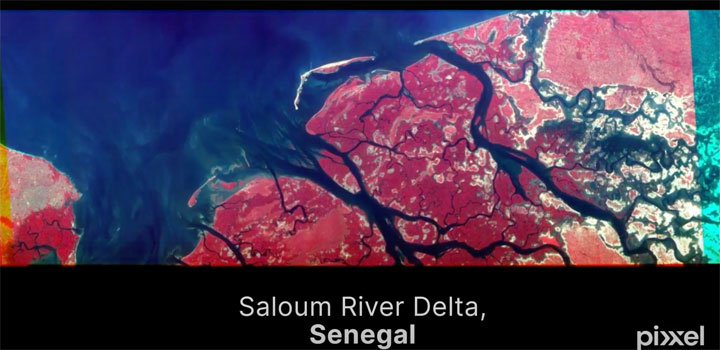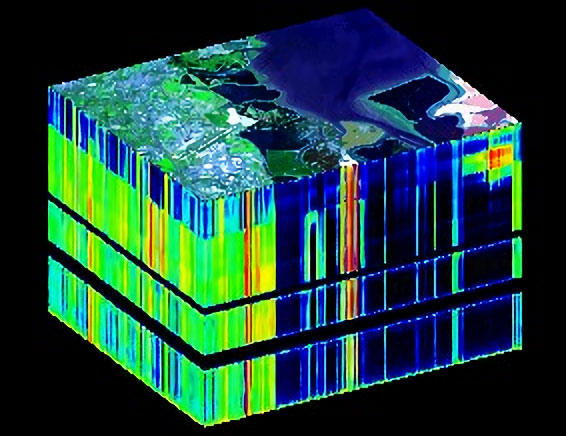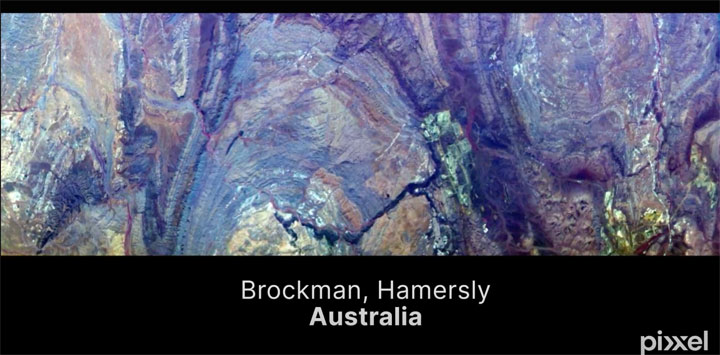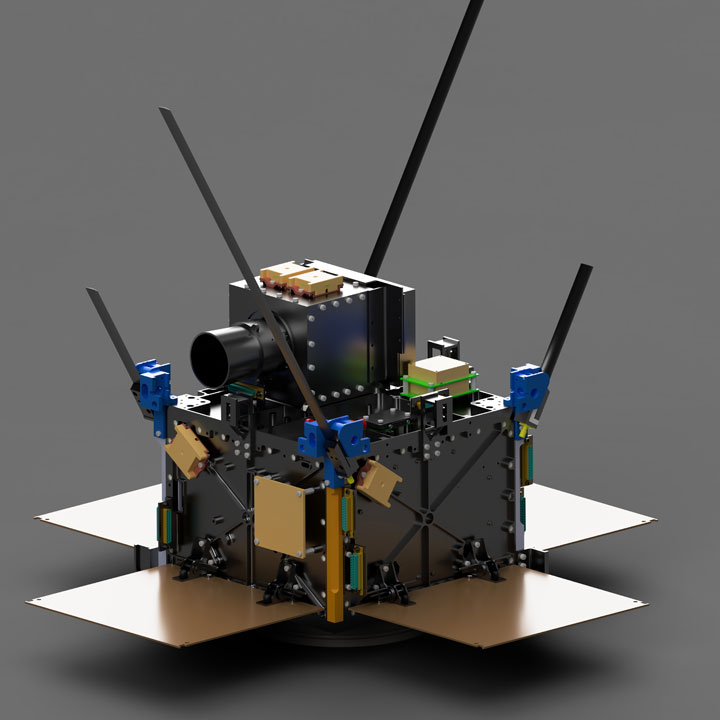 The image shows a hyperspectral image of the Saloum River Delta in Senegal captured by a Pixxel satellite. (Source: Pixxel)
The image shows a hyperspectral image of the Saloum River Delta in Senegal captured by a Pixxel satellite. (Source: Pixxel)
ALEXANDRIA, Va. — Determining the composition of an object on Earth from space is one of the most valuable capabilities of satellite-based hyperspectral imaging. Whether it’s analyzing soil composition, air and water quality or revealing a stealth object on the battlefield, commercial hyperspectral imaging (HSI) promises to unlock powerful insights.
At 24 years old, CEO and co-founder of Pixxel Awais Ahmed aims to deliver those insights to industry and government with one of the world’s first commercial hyperspectral satellite constellations. Pixxel recently made Fast Co.’s list of the 10 most innovative space companies as well as Via Satellite’s list of the 10 hottest satellite companies.
“The idea is simple,” Ahmed told Constellations. “There are a lot of things today’s satellites can’t see that hyperspectral satellites enable the world to see in a lot more detail.”
Pixxel has three demo satellites in orbit and is expected to increase capacity 1,000 times after completing six scheduled launches this year. The end goal: a constellation of 24 high-resolution hyperspectral imaging satellites in low-Earth orbit that can provide daily, global coverage and serve as “health monitor for the planet.”
Unlike electro-optical satellites that collect in the visible spectrum, or multispectral satellites that divide light into a few dozen bands, hyperspectral satellites divide light into hundreds of narrow bands. Combining traditional spectroscopy with modern imaging systems, HSI sensors measure the spectrum of light reflected in each pixel. These measurements can be analyzed for spectral signatures to identify the components of objects on the surface of Earth from space.
 Hyperspectral satellites observe Earth’s surface in hundreds of wavelengths per individual pixel. HSI sensors divide light into hundreds of narrow wavelengths to reveal spectral signatures of particular features, crops or materials, providing valuable data mineralogy, agricultural, environmental monitoring and more. (Source: NASA/JPL)
Hyperspectral satellites observe Earth’s surface in hundreds of wavelengths per individual pixel. HSI sensors divide light into hundreds of narrow wavelengths to reveal spectral signatures of particular features, crops or materials, providing valuable data mineralogy, agricultural, environmental monitoring and more. (Source: NASA/JPL)
Creating a Market
HSI satellites are relatively new and rare, compared to other forms of remote sensing. The first hyperspectral satellites were deployed in the early 2000s, largely for national security and scientific missions. Today, the addressable market for commercial HSI satellites is growing, driven by agriculture, defense and efforts by governments and organizations to meet sustainable development goals.
The technology could be a game changer for resource management, precision agriculture, mining and climate monitoring. Phenomena like crop disease, mineral deposits and oil and gas leaks that are invisible to the eye can be detected using hyperspectral remote sensing. But there are hurdles to overcome in the process of making it a viable commercial technology
 A hyperspectral satellite image showing the Brockman mine sites in the Hamersley Range in Western Australia. (Source: Pixxel)
A hyperspectral satellite image showing the Brockman mine sites in the Hamersley Range in Western Australia. (Source: Pixxel)
“The two biggest challenges have always been limited funding—which thankfully is no longer the case. And second, is educating the market and finding customers so we can ensure there’s a market we can start catering to,” Ahmed explained.
Last year, Pixxel successfully closed a $25 million funding round, shoring up the financing to continue building its constellation. Other hyperspectral startups have also attracted significant private investment in the last year, including Orbital Sidekick and Wyvern.
The commercial rollout of the technology is expected to accelerate as operators deploy more capacity. In the past year, Pixxel announced partnerships with the cloud-based precision agriculture company DataFarming to monitor crop health, as well as the multinational mining giant Rio Tinto, to deliver insights on active mines and environmental impact. The company is also involved in the oil and gas sector and recently observed a controlled release to validate the ability to detect chemical leaks.
 Pixxel manufactures and integrates its hyperspectral cameras into all of its smallsats. The completed constellation will feature 24 satellites. (Source: Pixxel)
Pixxel manufactures and integrates its hyperspectral cameras into all of its smallsats. The completed constellation will feature 24 satellites. (Source: Pixxel)
Pixxel was also one of six satellite companies awarded an NRO contract to deliver HSI capabilities. The other providers are BlackSky Technology, HyperSat, Orbital Sidekick, Planet and Xplore. The added commercial hyperspectral satellite capabilities will help the intelligence agency identify the chemical signature of objects that would otherwise be hidden, such as decoy targets, camouflaged combat vehicles, illicit crops and indications of chemical, biological or nuclear weapons testing or production.
India’s Commercial Space Boom
Since completing his undergraduate degree just four years ago, Ahmed and co-founder Kshitij Khandelwal have been focused on proving that a high-quality HSI satellite constellation could be built and operated by a private entity. This included designing, manufacturing and integrating hyperspectral cameras and developing a software-as-a-service (SaaS) platform to deliver relevant data and industry-specific insights to customers.
Like many in the industry, Ahmed was always fascinated with space. As a student at India’s Birla Institute of Technology and Science, he joined a student satellite group working with the Indian Space Research Organization and was a founding member of Hyperloop India. As a finalist in the 2017 Hyperloop Pod Competition, he and his teammates traveled to SpaceX headquarters in California where he saw the Falcon 9 booster. “That’s when it clicked that I wanted to work in space for the rest of my life.”
 CEO and co-founder of Pixxel Awais Ahmed. (Source: Pixxel)
CEO and co-founder of Pixxel Awais Ahmed. (Source: Pixxel)
Currently, Pixxel has offices in Los Angeles and Bengalaru. It is on track to become India’s first commercial hyperspectral satellite constellation and part of the country’s burgeoning commercial space ecosystem.
Despite six decades of experience in space, India only recently began opening space to commercial actors. In 2020, the government began unveiling a series of policies to enable greater public-private space collaboration. This has spurred exponential growth in the number of new space technology startups, a massive increase in investment and the country’s first commercial rocket launch in 2022.
The policy changes in India are now unlocking “technology and experience that was pent up for years,” said Ahmed. Pixxel is helping to realize the potential of India’s private space economy, as well as contributing to U.S. space capabilities.
“There’s a lot of catching up to do, especially with other countries, in terms of building imaging constellations,” Ahmed said of India’s booming private space ecosystem. Even with its rapid growth, a mature private space sector will not emerge overnight. “In the next two to three years, we’ll hopefully start to see a big ecosystem come up there, too.”
Explore More:
The Complicated History of U.S. Commercial SAR
Why DIA Wants More Commercial SDA Partners
Podcast: Data Fusion and Sovereign Earth Observation
